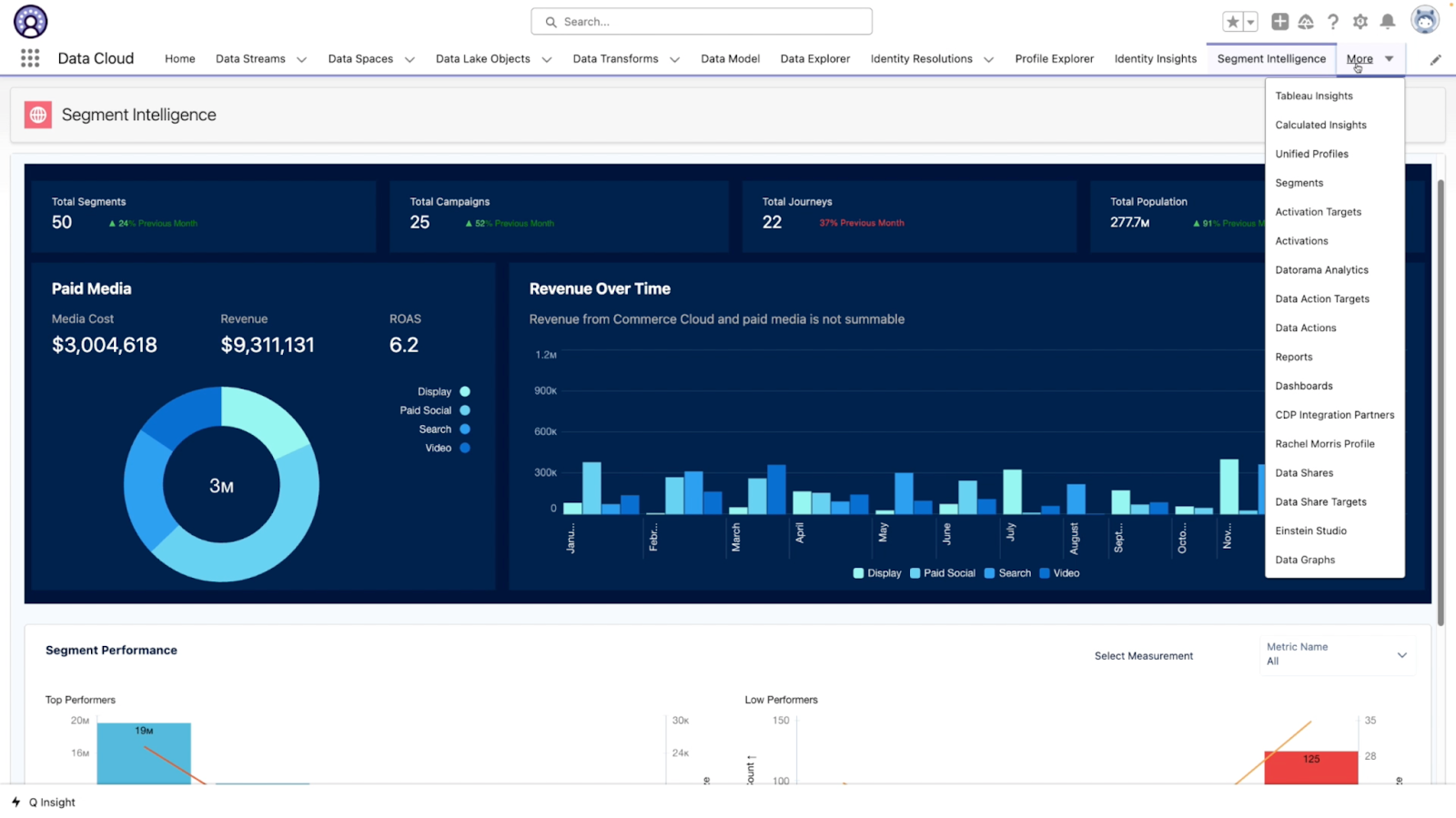First-Party Data: How You Can Succeed in a Cookieless World

Third-party cookies are going away. Here’s why first-party data is your best friend in this fast-evolving era.
What you’ll learn
- What is first-party data and why is it so important?
- Build the culture and infrastructure to adapt to first-party data
- Find tools and tactics that work – and stop using old methods that don’t
- Get the most out of your first-party data
- Understand how first-party data impacts generative AI
The era of third-party data is just about over – long live first-party data. Legislation, regulation, and an increasingly data-conscious audience have put an end to third-party cookies as a viable primary data source, pushing marketers to look for more sustainable ways to learn about their customers. First-party data — information volunteered by customers — is now a crucial source for the modern marketer.
Living in a first-party data world means actionable data comes from strong customer relationships. Trust has always been an important tool in this, as customers need to trust that you’re going to keep their data secure. But given the ongoing transformation in advertising, building trust is now more crucial than ever before. Without trust, even the most strategic marketing efforts can falter.
But first, let’s define first-party data and how it plays a role in today’s marketing landscape.
Make decisions smarter & faster
Learn how you can act on insights with AI and unify your data into a single profile to deliver the best customer experience.



What is first-party data and why is it so important?
First-party data is the information you collect directly from customers on your company’s channels. This can be through purchase data, behavior on your website, interactions with customer service agents, and more. It includes both basic information like their names, IPs, and email addresses, as well as more granular data like their purchase history, demographics, website activity, app data, and so-forth.
The big difference from the old third-party cookie system is it’s all coming from their direct interactions with your content. There’s no more following people to other websites and logging things they do elsewhere. While this can mean less total data, it also means you’re getting more relevant data. How they behave with your content is always going to matter more than how they behave with anyone else’s.
In this cookieless era, here are four things marketers must keep in mind moving forward.
1. Build the culture and infrastructure to adapt to first-party data
Adapting to focus on first-party data is more than simply flipping a switch. Let’s break down a hypothetical example, showing you how to capture, organize, and put your first-party data into action through every stage of the funnel.
Our hypothetical company is TechBat, and they specialize in cloud-based project management solutions. TechBat aims to use its first-party data to launch a comprehensive campaign promoting its new artificial intelligence (AI)-powered project management tool designed for small to medium-sized businesses (SMBs).
So how do they get started?
- Data prep: Collect and unify first-party data from across web, advertising, marketing, and all customer relationship management (CRM) data into a single view of their customers and contacts.
- Data analysis: TechBat’s marketing team analyzes that first-party customer data to identify businesses that have shown interest in AI technology through newsletter sign-ups, webinar participation, and those who have inquired about AI features in the past year. They then can use these insights to create buying likelihood scores for different interested businesses.
- Segmentation: TechBat segments the audience into three key groups: AI Enthusiasts (businesses that have actively engaged with AI content), Efficiency Seekers (businesses that have searched for productivity solutions), and “BatHeads” (existing customers who are frequent users of the platform and/or members of their loyalty program).
- Strategy development: For each segment, the marketing team develops specific campaign messages based on their observed interests. AI Enthusiasts receive messages spotlighting the newest and most exciting features of the AI-powered tool, Efficiency Seekers are targeted with content emphasizing productivity gains and time saved, and BatHeads get personalized upgrade offers.
- Activation: To put this all into motion, TechBat uses Salesforce products like Marketing Cloud Engagement or Account Engagement with Data Cloud Advertising solutions to create a personalized customer journey across paid and owned channels. They also trigger alerts in Slack for reps with relevant talking points or email templates for targeted follow-ups.
Alternately, what does it look like for a more B2C company? This video breaks down how a hypothetical sports retailer, Northern Trail Outfitters, can use their first-party data for campaign planning, audience building, and audience activation:
2. Find tools and tactics that work – and stop using old methods that don’t
It’s important to keep in mind that tailored strategies will always win out over general ones. In the context of a cookieless future, these tailored approaches mean finding new ways to accomplish or replace allegedly “essential” advertising practices that are no longer going to be viable, at least not in the form we knew them.
Here a few examples of important advertising tools that are going to work differently, or not at all, in a world without third-party cookies:
Retargeting
Without third-party data, you won’t be able to retarget to customers based on what they’ve done elsewhere, or how they browse. No more aggregating everything they do without their knowledge. Now marketers need to work exclusively with what customers give us (when we put it like that, we probably should have gotten rid of third-party cookies ages ago, huh?).
Cross domain tracking
Once used to track visitor behavior across multiple domains or subdomains, cross domain tracking was almost entirely reliant on third-party cookies — so now it’s dead.
Multi-touch attribution measurement
This can still exist, but it’s going to require a lot more trust. Customers have to choose to share their information with you now, you can’t just harvest it naturally from their journey or follow their digital footprint across touchpoints.
So how would a company like TechBat build their strategy without relying on those tools?
- Email campaigns: They send tailored emails to each segment, with personalized messages and offers based on their previous interactions with TechBat. Since the data all came from direct interactions, none of it’s compromised by evolving privacy regulations or third party depreciation.
- Content marketing: TechBat publishes case studies, blog posts, and whitepapers tailored to each of their audience segments’ interests. They promote these through their newsletter, social media channels, and website landing pages.
- Server-to-server event tracking: Replacing pixel-based tracking with server-to-server solutions, such as Meta’s conversion APIs, TechBat can optimize campaign performance, attribute conversions, and run remarketing campaigns.

3. Get the most out of your first-party data
Knowing we need to rely on first-party data is one thing, but making sure it’s handled properly is another. There are a few basic steps you should follow to make sure you’re getting the data you need while still respecting your audience’s preferences and boundaries.
- Inform customers about what data is being collected, how it will be used, and who it will be shared with.
- Offer customers control over their data with easy opt-in and opt-out mechanisms.
- Assure customers their data is protected with robust security measures. Transparency is important here; it’s not enough just to have strong security, you need to make sure your customers know about it.
- Build trust and loyalty by demonstrating that you value their contribution with a clear value exchange. Don’t ask for something for nothing. There are tons of ways to reward customers for their trust, such as personalized discounts and offers, exclusive access, loyalty or rewards programs, or early access opportunities.
- Capture data that will help you personalize messages, create trusted customer relationships, and support addressability across a number of systems and devices. Some of the key forms of that data are email addresses, phone numbers, names, mobile device IDs, and over the top (OTT) IDs.
That’s the privacy and responsibility side of the coin taken care of, but how about the optimization side? Let’s take a look at a few different use cases for your first-party data.
Increase lead conversion via connected lead management
You can use digital engagement behavior, demographic data, and more, to optimize ad spend, drive pipeline and inform personalized advertising campaigns.
Start by creating a high-value target audience based on unified behavior signals, purchase data, demographic insights, and other factors. Get “propensity-to-buy” scores for more granular segmentation, then activate segments across advertising channels.
You can use personalized advertisements and online experiences that build awareness and deliver knowledge-building content with “request information” calls-to-actions. Finally, you can analyze segment/activation performance across ad platforms to track return on investment and adjust your ad strategy going forward.
Increase awareness of available offerings
With great first-party data, you can create high-value segments based on previous visits or purchases, demographics, historical marketing engagement, and engagement scores.
You can increase reach, as needed, using lookalike segments to find potential customers most similar to your target audience, or identify existing customers who use one service that correlates highly with those who use another.
You can also activate segments to ad partners like Google, Meta, or Amazon directly from Data Cloud to reach customers with personalized ads. With Salesforce, you can combine Data Cloud and Marketing Cloud Personalization to personalize the website experience for subsequent visits.
Decrease cost per acquisition through targeted advertising
Another big plus to using first-party data instead of third-party cookies? You can find more customers that look like your best customers, without increasing budget, by using advanced campaign planning, AI-powered audience-building, and advertising activation.
Within Salesforce Data Cloud, you can measure the effectiveness of historical and current advertising campaigns using Segment Intelligence to understand best performing audiences and inform future activations. You’ll get affinity, demographics, and in-market trend data back from ad partners like Google and Amazon. This will help you improve return on ad spend (ROAS) and inform future campaign planning. Then you can use AI-powered segment creation to build a high-value audience to promote to.

Use lookalike modeling to identify similar customers to expand campaign reach, and activate new audiences to ad platforms of choice to reach them with personalized ads. Then you can collect segment-level insights directly from ad partners to understand customer affinities and demographics you can use to further your personalization — giving future campaigns a head start.
Those are three high-value general use cases, but what does it look like specifically when a company like TechBat uses their first-party data to build a campaign?
- They use the insights they gathered from their first-party data and campaign planning phase to inform content, medium, channels, and sequencing. Since they have Salesforce technology, they use AI capabilities to optimize this process, building lookalike audiences, prioritizing via scoring models, and using Data Cloud Segment Intelligence to analyze and refine their segmentation.
- They sequence their messaging and paid media to optimize conversions and spend based on known customer preferences and behaviors, such as communicating via email vs. chat. They can deliver relevant targeted advertising if the desired engagement hasn’t occurred within a preferred time frame.
- They use their audience segments to deliver targeted emails, LinkedIn ads, and personalized content marketing that highlights the appropriate content categories based on each segment of interest. They deliver different content going to segments that are more interested in the tech side of AI instead of those more concerned with pure efficiency that are less worried about how the sausage is made.
- TechBat adds in additional attribute criteria for further dynamic personalization even within segments in the channels that support it, such as email campaigns. They also include exclusion rules within each segment so that converted users are no longer targeted for the respective campaign.
- Finally, they use data analysis and ongoing monitoring to continuously iterate and fine-tune their campaign as more first-party data comes in, much of it generated by the campaign itself.
4. Understand how first-party data impacts generative AI
All that first-party data also benefits your generative AI options. Generative content built off first-party data is, essentially, content the customer already told you they want. That doesn’t just mean marketing data, either. Generative AI can build off data from across your entire business, including sales, service, or account data.
Using generative AI lets you deliver that “have it your way” level of personalization at scale, giving every customer a version of your campaign that’s just right for them.
In TechBat’s case, this could pop up in a few places:
- Email marketing: Building custom emails for each segment or sub-segment, incorporating not just their areas of interest but their preferred content types or offers.
- Live search: Serves customers on the website auto-complete results or search recommendations that draw from what their first-party data already told you they’re interested in.
- Relevant offers: Provides different, relevant, custom-selected offers and content to different users on the website. A more techie user might see CTAs driving them towards a whitepaper, while a returning customer with a long purchase history might instead be presented with promotion for the loyalty program or subscription-based savings.
- Social media: Posts and variants automatically generated for each segment, so everyone is seeing the content most relevant to their interests.
This new frontier is an exciting time for marketers, but there’s more to it than just switching from third-party cookies to first-party data, even if that’s the backbone.
By carefully considering and selecting the right tools, building a cogent strategy, using generative AI to scale that strategy, and dealing honestly and intelligently with their audience, you can use that data to not only improve your marketing, but build better customer relationships.
Personalized content built from data they choose to share not only speaks to their interests and needs, it also shows respect for their privacy and, at the risk of sentimentality, “care.”
Adapting the methodology we showed for TechBat and Northern Trail Outfitters to suit your business is a good start to staying competitive in a first-party data world. But it’s equally important to make sure you have a solid data foundation for AI transformation beyond a single campaign. Put it all together, and you’re set up for success now, tomorrow, and deeper into the future.
Get the most out of your data
Learn how Data Cloud helps you deliver experiences that build lasting relationships with customers.



























